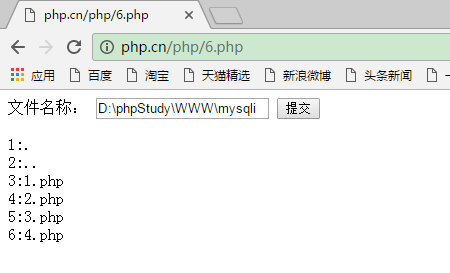Summary of examples shared about traversal
This article mainly introduces the example code of angularJS using ng-repeat to traverse a two-dimensional array. It has certain reference value. Interested friends can refer to the recent report projects. In one case, the background returns What I was given was a two-dimensional array. I put the data into the table in the foreground. Because we are using the front-end framework of AngularJS, we use ng-repeat to implement it: First in js: The code is as follows: $scope.Week = [[ 'Yunnan Province ', 'a', 's', 'd', 'e', 'w','t' ],[ 'Shaanxi Province ', 'l', 'p', '
1. Example code sharing about how angularJS uses ng-repeat to traverse a two-dimensional array

Introduction: This article mainly introduces the example code of angularJS using ng-repeat to traverse a two-dimensional array. It has certain reference value. Interested friends can refer to it
2. How to share the implementation code of how to traverse all images in a folder with Python and C++

##Introduction: This article mainly introduces the relevant information about the implementation code of traversing all the images in the folder in Python and C++. Friends in need can refer to
##3.Detailed explanation of how to implement binary trees and seven traversal methods in Python programming
 ##Introduction: This article It mainly introduces Python programming to implement binary trees and seven traversal methods. It analyzes the definition of Python binary trees and common traversal operation techniques in detail with examples. Friends in need can refer to
##Introduction: This article It mainly introduces Python programming to implement binary trees and seven traversal methods. It analyzes the definition of Python binary trees and common traversal operation techniques in detail with examples. Friends in need can refer to
4.
Detailed explanation of how to sort dictionary elements in a list using Python programming ## Introduction: This article It mainly introduces the method of Python programming to sort dictionary elements in a list, involving Python's operating skills related to traversing, reading, and converting list and dictionary elements. Friends in need can refer to the following
## Introduction: This article It mainly introduces the method of Python programming to sort dictionary elements in a list, involving Python's operating skills related to traversing, reading, and converting list and dictionary elements. Friends in need can refer to the following
5. Example of how to convert Chinese numbers into Arabic numerals in Python
 Introduction : This article mainly introduces Python's method of converting Chinese numbers into Arabic numerals, involving Python string traversal and conversion related operation skills. Friends in need can refer to
Introduction : This article mainly introduces Python's method of converting Chinese numbers into Arabic numerals, involving Python string traversal and conversion related operation skills. Friends in need can refer to
6. Linux uncommon but useful commands
 Introduction: which command is used to find and display to The absolute path of the specified command, and the directory that needs to be traversed when searching for the command is stored in the environment variable PATH.
Introduction: which command is used to find and display to The absolute path of the specified command, and the directory that needs to be traversed when searching for the command is stored in the environment variable PATH.
7. The difference between array_diff and other methods to implement PHP array traversal
 Introduction: You are given two arrays with 5000 elements each, and calculate their difference. To put it bluntly, it is to use PHP and the algorithm you think is the best to implement the array_diff algorithm. When I received this question for the first time, I found it to be very simple, so I wrote one based on my past experience:
Introduction: You are given two arrays with 5000 elements each, and calculate their difference. To put it bluntly, it is to use PHP and the algorithm you think is the best to implement the array_diff algorithm. When I received this question for the first time, I found it to be very simple, so I wrote one based on my past experience:
8. Techniques for filtering strings in Python
Introduction: The map function in Python is very useful. It has appeared in both the character conversion and character traversal sections. Now, it appears again, What kind of surprises will it bring us? Are you trying to tell us that map is great and we should play with it more in the future? 9. Python enumerate traverse array application Introduction: Python code for traversing arrays 10. How to traverse all files in a specified directory? (php file system operation) ## Introduction: In the acquired management system of the website, it is often necessary to modify the website To manage and maintain files in the server, sometimes you need to add a folder or delete a certain folder or file. In order to better view these files or folders, you need to traverse the files in the specified directory of the server. So how? How to implement the traversal function of files in this specified directory? [Related Q&A recommendations]: python specifies the position where the generator iteration starts java - How to get index when traversing list with each tag in Thymeleaf java reflection to get class attribute problem. android - During the image upload step, how to deal with the time-consuming method of saving the selected image locally? php - Mysql calling interface to achieve data synchronization problem


The above is the detailed content of Summary of examples shared about traversal. For more information, please follow other related articles on the PHP Chinese website!

Hot AI Tools

Undresser.AI Undress
AI-powered app for creating realistic nude photos

AI Clothes Remover
Online AI tool for removing clothes from photos.

Undress AI Tool
Undress images for free

Clothoff.io
AI clothes remover

Video Face Swap
Swap faces in any video effortlessly with our completely free AI face swap tool!

Hot Article

Hot Tools

Notepad++7.3.1
Easy-to-use and free code editor

SublimeText3 Chinese version
Chinese version, very easy to use

Zend Studio 13.0.1
Powerful PHP integrated development environment

Dreamweaver CS6
Visual web development tools

SublimeText3 Mac version
God-level code editing software (SublimeText3)

Hot Topics
 1387
1387
 52
52
 Java how to loop through a folder and get all file names
Mar 29, 2024 pm 01:24 PM
Java how to loop through a folder and get all file names
Mar 29, 2024 pm 01:24 PM
Java is a popular programming language with powerful file handling capabilities. In Java, traversing a folder and getting all file names is a common operation, which can help us quickly locate and process files in a specific directory. This article will introduce how to implement a method of traversing a folder and getting all file names in Java, and provide specific code examples. 1. Use the recursive method to traverse the folder. We can use the recursive method to traverse the folder. The recursive method is a way of calling itself, which can effectively traverse the folder.
 PHP glob() function usage example: traverse all files in a specified folder
Jun 27, 2023 am 09:16 AM
PHP glob() function usage example: traverse all files in a specified folder
Jun 27, 2023 am 09:16 AM
Example of using PHPglob() function: Traverse all files in a specified folder In PHP development, it is often necessary to traverse all files in a specified folder to implement batch operation or reading of files. PHP's glob() function is used to achieve this requirement. The glob() function can obtain the path information of all files that meet the conditions in the specified folder by specifying a wildcard matching pattern. In this article, we will demonstrate how to use the glob() function to iterate through all files in a specified folder
 In-depth comparison of Java Iterator and Iterable: pros and cons analysis
Feb 19, 2024 pm 04:20 PM
In-depth comparison of Java Iterator and Iterable: pros and cons analysis
Feb 19, 2024 pm 04:20 PM
Conceptual differences: Iterator: Iterator is an interface that represents an iterator that obtains values from a collection. It provides methods such as MoveNext(), Current() and Reset(), allowing you to traverse the elements in the collection and operate on the current element. Iterable: Iterable is also an interface, representing an iterable object. It provides the Iterator() method, which returns an Iterator object to facilitate traversing the elements in the collection. Usage: Iterator: To use Iterator, you need to first obtain an Iterator object, and then call the MoveNext() method to move to the next
 How to use the os module to traverse files in a directory in Python 3.x
Jul 29, 2023 pm 02:57 PM
How to use the os module to traverse files in a directory in Python 3.x
Jul 29, 2023 pm 02:57 PM
How to use the os module to traverse files in a directory in Python3.x In Python, we can use the os module to operate files and directories. The os module is an important module in the Python standard library, providing many operating system-related functions. In this article, we will explain how to use the os module to iterate through all files in a directory. First, we need to import the os module: importos Next, we can use the os.walk() function to walk the directory.
 How to implement binary tree traversal using Python
Jun 09, 2023 pm 09:12 PM
How to implement binary tree traversal using Python
Jun 09, 2023 pm 09:12 PM
As a commonly used data structure, binary trees are often used to store data, search and sort. Traversing a binary tree is one of the very common operations. As a simple and easy-to-use programming language, Python has many methods to implement binary tree traversal. This article will introduce how to use Python to implement pre-order, in-order and post-order traversal of a binary tree. Basics of Binary Trees Before learning how to traverse a binary tree, we need to understand the basic concepts of a binary tree. A binary tree consists of nodes, each node has a value and two child nodes (left child node and right child node
 Recursively insert and traverse linked list in C++
Sep 10, 2023 am 09:21 AM
Recursively insert and traverse linked list in C++
Sep 10, 2023 am 09:21 AM
We get the integer values used to form the linked list. The task is to first insert and then traverse the singly linked list using recursive method. Add node recursively at the end if head is NULL → add node to head otherwise add to head (head → next) recursively traverse nodes if head is NULL → exit otherwise print (head → next) Example input −1-2-7-9 -10 output outputstrong>− linked list: 1→2→7→9→10→NULL input−12-21-17-94-18 output− linked list: 12→21→17→94→18→NULL used in the following program The method is as follows In this method, we will use the function to add nodes and traverse the singly linked list and pass
 Java Iterator and Iterable: The key to collection traversal, demystified
Feb 20, 2024 am 10:27 AM
Java Iterator and Iterable: The key to collection traversal, demystified
Feb 20, 2024 am 10:27 AM
Introduction to IteratorIterator is an interface in Java for traversing collections. It provides a set of methods that allow you to access elements in a collection in a sequential manner. You can use Iterator to iterate over collection types such as List, Set, and Map. Demo code: Listlist=newArrayList();list.add("one");list.add("two");list.add("three");Iteratoriterator=list.iterator();while(iter
 Java Iterator vs. Iterable: Unlocking the Power of Java Collections
Feb 19, 2024 pm 07:00 PM
Java Iterator vs. Iterable: Unlocking the Power of Java Collections
Feb 19, 2024 pm 07:00 PM
In Java, a collection is a collection of elements that provides a unified interface and methods to store, retrieve and operate these elements. Iterator and Iterable are two important Java interfaces that provide a common mechanism for traversing collection elements. The Iterator interface defines hasNext() and next() methods for traversing collections. The hasNext() method is used to check whether there are any untraversed elements in the collection, and the next() method is used to return the current element and move it to the next element. The Iterable interface defines the iterator() method, which returns an Iterator object for traversing the elements in the collection.




